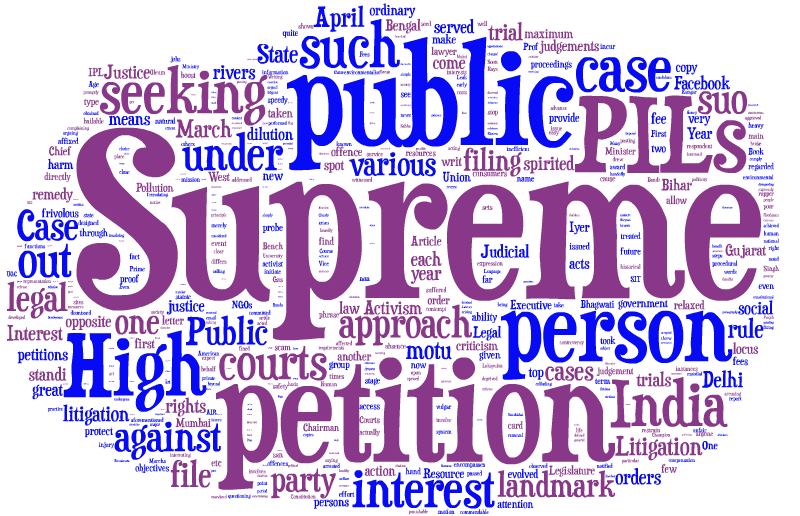PROBLEMS FACING PUBLIC INTEREST LITIGATION IN INDIA By Nishita Kapoor 4th year B.Com.LLB(Hons.) at UILS,Panjab University
Introduction
The traditional rule of “Locus Standi” implies that only a person whose rights have been infringed can file a petition before the court. But the Apex Court has allowed relaxation in this rule, by incorporating the concept of “Public Interest Litigation”, which means litigating before the court of law for the interest of larger public. It is an instrument provided to the public spirited persons to seek redress for the violation of the rights of public.
But there are certain problems faced in Public Interest Litigation which tend to transform this instrument into a form of a weapon, which thereby tends to prejudice the success of PIL in India. Some of the problems faced are:
- PUBLICITY UNDER THE VEIL OF PUBLIC INTEREST LITIGATION.
There are numerous cases in which it has been observed that the irresponsible citizens impair the essence of PIL and use it as a tool for gaining publicity. The ‘P’ in PIL means Public and not publicity.[1] It is one of the major problems faced in this form of litigation as the litigation rather than using this instrument in a constructive way, use it as a means to get popular or for coming into limelight. Some of the recent instances of this kind of abuse are as follows:-
- A PIL filed against the movie Kedarnath on the ground that such films hurt religious sentiments as the movie shows a Muslim boy at Kedarnath(Hindu Temple). The court dismissed the petition as a “Publicity Stunt”.[2]
- A PIL was filed seeking the medical evaluation of the Chief Minister was filed at Bombay High Court. The court dismissed the petition as publicity interest litigation as the petitioner didn’t disclose the facts regarding his political affiliation and made baseless allegations.[3]
- JUDICIAL ADVENTURISM
Judicial Overreach occurs when the Judiciary interferes in the spheres of Executive or the Legislature and violates the separation of powers enriched in the Article 50 of the Constitution. Some of the instances of judicial overreach in the public interest litigation are:-
- A petition was filed against the certificate granted to the film Jolly LLB 2 and the Bombay High Court ordered to cut four scenes on the ground of being defamatory to judiciary. It is instance of unnecessary interference as under the Cinematograph Act, 1952 courts have no power to refuse, modify or certify the certificate granted to films.[4]
- In a PIL related to road safety and problem of drunk driving, the Supreme Court banned sale of liquor along the state and national highways.[5] It applies to all hotels and restaurants within 500 meters of highway under the ban.
This was an administrative issue and court was not an appropriate authority to pass such order.
- SYMBOLIC JUSTICE
PIL reflects “Symbolic Justice” as sometimes the directions issued in the PIL are not implemented, which thereby affects the credibility of the judiciary. The Apex Court issued directions related to sexual harassment[6], procedure of arrest [7]etc. but often it is unable to check its compliance.
- OBSCURE MOTIVES OF THE LITIGANTS
It is the general principle of law that “One should come with clean hands to the courts” but sometimes the personal grievances or political motives are masked under the cover of Public Interest Litigation. Such PILs should be dismissed and court should not proceed further with them. However, sometimes it becomes to decipher such ulterior motives and hence, this destroys the essence of PIL. Though by a series of judgments various guidelines have laid down which are to be followed while entertaining PILs[8]. Also it is being misused as no heavy court fees are involved as in the case of ordinary civil proceedings.
- TREMENDOUS INCREASE IN LITIGATION
Due to the flexible and non-complex process of filing a PIL, the filing of indiscriminate petitions creates a lot of pressure on the judicial system and delays the process of disposal of bona fide petitions.
- INSTITUTIONAL LIMITATIONS
There is a major need for structural change in the operation of PIL cells. In the case of Nilima Priyadarshini v. State of Bihar[9], a letter written by a person who was illegally detained was placed before the court, two and half months after the PIL call had received it. Another serious institutional limitation is that the bench structure keeps on fluctuating.
Footnotes:
[2] Nikunj Soni, “HC rejects PIL against Kedarnarth ,calls it publicity stunt”, Ahmedabad Mirror, Dec 5,2018
[3] Prakash Kamat, “ High Court of Bombay at Goa dismisses petition seeking Manohar Parrikar’s Medical examination”, The Hindu, Dec 20,2018
[4] Nitish Kashyap,” Jolly LLB 2 can be screened only after 4 scenes are deleted : Bombay High Court”, Economic Times, Feb 07,2017
[5] Simar Singh, “ NO liquor Shops on Highways from April 1 : SUPREME COURT”, Dec 11, 2017
[6] Vishaka v. State of Rajasthan, AIR 1997 SC 3011
[7] D.K. Basu v. State of West Bengal, (1997) 1 SCC 416
[8] In S.P. Gupta v. President of India (AIR 1982 SC 149), it was held that court should not allow its process to be misused by a person who is acting for personal gain or private profit and must reject his application at the threshold.
[9] AIR 1987 SC 2021
 3613
3613

